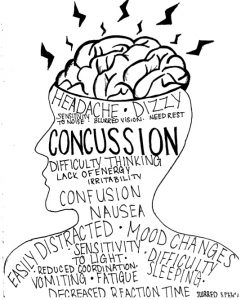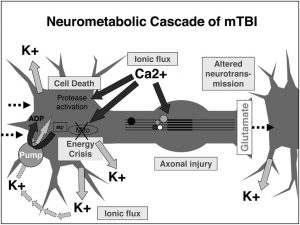Imagine you are at a high school football game. The tension in the air is thick as the play is ran, and you see a player that is hit, who falls down to the ground with a thud and doesn’t get back up right away. Generally, a medic/trainer will run out to the field and complete an assessment of the player to make sure they’re physically okay and check for a possible concussion. The player gets back up, shakes it off, and keeps playing. Do you think about it anymore after that? Concussions, or mild traumatic brain injuries (mTBIs), don’t necessarily always have to be symptomatic concussions or knock out the person, but they can put someone at an elevated risk of future concussions and can result in long-term impairments.
What are Concussions?
When we think of concussions, we tend to think of a hard hit to the head, one that may make you dizzy or confused, maybe even knock you unconscious. There’s a lot more that goes on though during a concussion than most people realize, and it’s important to know what is going on during a concussion to recognize the signs of one. A concussion, or mTBI, occurs when there is a significant blow or hit to the head that causes the brain to bruise, and rebound off the other side of the skull; this rebounding is referred to as the contrecoup. This rattling of the brain can disrupt axons and rupture the blood vessels. After a concussion occurs, the person may experience a variety of symptoms. They may have any of the following: headaches, confusion, dizziness, memory loss, nausea, blurred vision, sensitivity to noise and light, sleeping disturbances, mood changes, especially irritability, and may display slurred speech. To read more on the types of symptoms, you can read here: https://www.mayoclinic.org/diseases-conditions/concussion/symptoms-causes/syc-20355594
A concussion does not always create these symptoms though. People can also undergo sub-concussive impacts, which are blows to the head that do not cause full concussions. These types of hits can be incredibly dangerous because the person who has been hit may think they are fine because they have no symptoms, but the impact is putting them at a very high risk of developing a full concussion.
Inside the Brain
Now that we know what is occurring symptomatically during a full concussion, what is happening in the pathophysiology of the brain to result in these impairments? When a mTBI occurs, a neurometabolic cascade occurs. In the initial stages of the cascade, an ionic flux and depolarization occurs, which triggers excitatory neurotransmitters like glutamate to be released. There are ATP-ionic pumps within the membrane that are overstimulated due to this and creates an increase in ADP, an efflux of potassium, hyperglycolysis, and an influx of calcium. This creates an imbalance, or energy crisis. The imbalance ultimately leads to damage of axonal integrity, mitochondrial dysfunction, and altered neurotransmission. It’s also important to note the role of inflammation after a mTBI. Microglia are activated after a blow to the head, stimulating upregulation of cytokine, and ultimately activating inflammatory genes. Inflammation can result in severe headaches, or even rupturing blood vessels in the brain. Due to these pathophysiology changes that occur from a mTBI, long-term structural changes can occur within the brain and result in atrophy.
Looking Forward
Researching concussions has become a hotspot in the neuroscience community due to the prevalence it has in the sport world. Many athletes in contact sports like football, boxing, or hockey experience multiple concussions within their life and can suffer from long-term, symptomatic impairments that affect their everyday life. There are many athletes who have received so many hits to the head, especially boxers, that are at an elevated risk of developing chronic traumatic encephalopathy (CTE), which is a progressive neurodegenerative disease. CTE develops after years of repetitive symptomatic concussions and sub-concussive impacts and tends to cause severe memory loss, confusion, impulsivity, depression, and aggression. It’s important to be researching concussions to possible prevent CTE or multiple concussions from occurring. Young athletes are especially vulnerable to this due to the brain’s development, which means at a younger age there are more unmyelinated axons that are vulnerable to injury. With so many young people participating in sports and being placed at a higher risk of developing a concussion, society needs to look at different preventative measures that can be put into place to try and fully prevent mTBIs, or curb the progression to CTE.
References:

